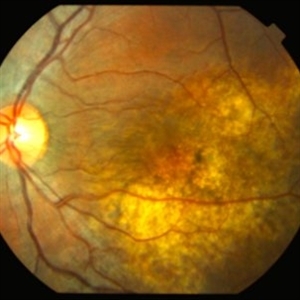This 13 year old girl presented with mild painless progressive blurring of central vision left eye over the past several months. Visual Acuity was 20/25. She was noted to have a normal posterior segment on the right. In the affected left eye, retinal examination revealed a relatively flat, lightly pigmented lesion, with well-defined and scalloped edges. Clumps of associated pigment were noted. The OCT image shows subretinal fluid just inferior to the fovea. Choroidal osteoma can be associated with the development of subretinal neovascularization (particularly at the edges of the osteoma). Findings were suggestive of an early choroidal osteoma with some high echodensity on B scan ultrasound. Choroidal osteoma are usually unilateral, occur most often in females, and are diagnosed in the teen years.
-
 Choroidal Osteoma
Choroidal Osteoma
Nov 21 2014 by Thomas A. Ciulla, MD, MBA, FASRS
This 13-year-old girl presented with mild painless progressive blurring of central vision left eye over the past several months. Visual acuity was 20/25. In the affected left eye, retinal examination revealed a relatively flat, lightly pigmented lesion, with well-defined and scalloped edges. Clumps of associated pigment were noted.
Photographer: Thomas Steele
Condition/keywords: choroidal neovascular membrane (CNVM), choroidal neovascularization (CNV), choroidal osteoma, macular choroidal osteoma
-
 Choroidal Osteoma
Choroidal Osteoma
Nov 21 2014 by Thomas A. Ciulla, MD, MBA, FASRS
This 13-year-old girl presented with mild painless progressive blurring of central vision left eye over the past several months. Visual acuity was 20/25. In the affected left eye, retinal examination revealed a relatively flat, lightly pigmented lesion, with well-defined and scalloped edges. Clumps of associated pigment were noted.
Photographer: Thomas Steele
Condition/keywords: choroidal neovascular membrane (CNVM), choroidal neovascularization (CNV), choroidal osteoma, macular choroidal osteoma
-
 Choroidal Osteoma
Choroidal Osteoma
Nov 21 2014 by Thomas A. Ciulla, MD, MBA, FASRS
This 13-year-old girl presented with mild painless progressive blurring of central vision left eye over the past several months. Visual acuity was 20/25. In the affected left eye, retinal examination revealed a relatively flat, lightly pigmented lesion, with well-defined and scalloped edges. Clumps of associated pigment were noted. This OCT image shows subretiinal fluid just inferior to the fovea. Choroidal osteoma can be associated with the development of subretinal neovascularization (particularly at the edges of the osteoma).
Photographer: Thomas Steele
Condition/keywords: choroidal neovascular membrane (CNVM), choroidal neovascularization (CNV), choroidal osteoma, macular choroidal osteoma
-
 Choroidal Osteoma
Choroidal Osteoma
Nov 21 2014 by Thomas A. Ciulla, MD, MBA, FASRS
This 13-year-old girl presented with mild painless progressive blurring of central vision left eye over the past several months. Visual acuity was 20/25. In the affected left eye, retinal examination revealed a relatively flat, lightly pigmented lesion, with well-defined and scalloped edges. Clumps of associated pigment were noted. This OCT image shows subretiinal fluid just inferior to the fovea. Choroidal osteoma can be associated with the development of subretinal neovascularization (particularly at the edges of the osteoma).
Photographer: Thomas Steele
Condition/keywords: choroidal neovascular membrane (CNVM), choroidal neovascularization (CNV), choroidal osteoma, macular choroidal osteoma
-
 Choroidal Osteoma
Choroidal Osteoma
Nov 21 2014 by Thomas A. Ciulla, MD, MBA, FASRS
This 13-year-old girl presented with mild painless progressive blurring of central vision left eye over the past several months. Visual acuity was 20/25. In the affected left eye, retinal examination revealed a relatively flat, lightly pigmented lesion, with well-defined and scalloped edges. Clumps of associated pigment were noted. This OCT image shows subretiinal fluid just inferior to the fovea. Choroidal osteoma can be associated with the development of subretinal neovascularization (particularly at the edges of the osteoma).
Photographer: Thomas Steele
Condition/keywords: choroidal neovascular membrane (CNVM), choroidal neovascularization (CNV), choroidal osteoma, macular choroidal osteoma
-
 Choroidal Osteoma
Choroidal Osteoma
Nov 21 2014 by Thomas A. Ciulla, MD, MBA, FASRS
This OCT image shows subretiinal fluid just inferior to the fovea. Choroidal osteoma can be associated with the development of subretinal neovascularization (particularly at the edges of the osteoma).
Condition/keywords: choroidal neovascular membrane (CNVM), choroidal neovascularization (CNV), choroidal osteoma, macular choroidal osteoma
-
 Choroidal Osteoma
Choroidal Osteoma
Dec 6 2014 by Thomas A. Ciulla, MD, MBA, FASRS
Note the highly reflective lesion in the posterior pole.
Condition/keywords: choroidal osteoma
